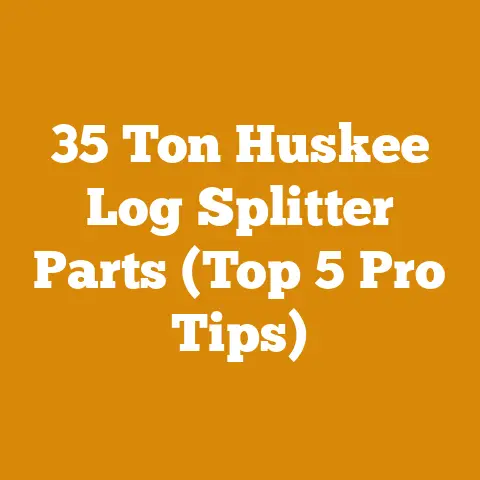Stump Grinding Insurance Tips (5 Pro Secrets for Arborists)
Affordability. It’s the elephant in the room when we talk about insurance, isn’t it? Especially when you’re running a stump grinding business, where the risks are as real as the chips flying from your machine. I’ve been in the wood processing and tree care game for over 20 years, and I’ve seen firsthand how a single accident can devastate a small business if it’s not properly insured. But, let’s be honest, insurance premiums can take a significant bite out of your profits. So, how do you protect your livelihood without breaking the bank? That’s what I’m here to share with you: five pro secrets for arborists to get the stump grinding insurance you need at a price you can afford. These aren’t just theoretical concepts; they’re strategies I’ve used, tweaked, and perfected over the years, and I’m confident they can help you too.
Stump Grinding Insurance Tips: 5 Pro Secrets for Arborists
1. Understand Your Risks and Tailor Your Coverage
Many arborists make the mistake of purchasing a “one-size-fits-all” insurance policy. But here’s the thing: every business is different. The risks you face depend on the size of your operation, the types of jobs you take on, and even the geographic location where you work.
- Identify Your Specific Risks: Start by making a detailed list of all the potential risks associated with your stump grinding business. This could include:
- Property damage caused by flying debris.
- Injuries to workers or bystanders.
- Damage to underground utilities.
- Equipment theft or damage.
- Liability for faulty workmanship.
- Prioritize Your Risks: Once you have a list, prioritize the risks based on their likelihood and potential impact. Focus on the risks that are most likely to occur and would cause the most significant financial damage. For example, if you operate in a densely populated area, the risk of property damage might be higher than the risk of equipment theft.
- Choose the Right Coverage: With a clear understanding of your risks, you can tailor your insurance coverage to meet your specific needs. Don’t overpay for coverage you don’t need, but make sure you have adequate protection for the risks you face. For example, you might consider:
- General Liability Insurance: This covers bodily injury and property damage to third parties.
- Commercial Auto Insurance: This covers accidents involving your work vehicles.
- Workers’ Compensation Insurance: This covers medical expenses and lost wages for employees injured on the job.
- Equipment Insurance: This covers damage or theft of your stump grinder and other equipment.
- Professional Liability Insurance (Errors and Omissions): This covers you if you make a mistake that causes financial harm to a client.
My Experience: I remember one time when I was removing a particularly large stump near a client’s swimming pool. Despite my best efforts, a large chunk of wood flew off the grinder and cracked the pool liner. Fortunately, I had adequate general liability insurance, which covered the cost of repairing the pool. Without that coverage, I would have been on the hook for thousands of dollars.
Data Point: According to a study by the Small Business Administration, 43% of small businesses close within the first five years due to financial losses. Having the right insurance coverage can help you avoid becoming one of those statistics.
2. Shop Around and Compare Quotes
Don’t settle for the first insurance quote you receive. Insurance rates can vary significantly from one company to another, so it pays to shop around and compare quotes from multiple providers.
- Get Multiple Quotes: Contact at least three different insurance companies and ask for quotes on the coverage you need. Be sure to provide accurate information about your business, including your annual revenue, the number of employees you have, and the types of jobs you take on.
- Compare Coverage and Rates: Don’t just focus on the price. Compare the coverage offered by each policy to make sure it meets your needs. Look for policies with adequate liability limits, deductibles you can afford, and exclusions that don’t leave you vulnerable.
- Consider Independent Agents: Independent insurance agents can be a valuable resource. They work with multiple insurance companies and can help you find the best coverage at the best price. They can also provide expert advice and guidance on choosing the right policy for your business.
My Experience: I used to stick with the same insurance company year after year, thinking I was getting a good deal. But one day, I decided to shop around and was shocked to find that I could save over $1,000 a year by switching to a different provider. That’s money I could use to invest in new equipment or expand my business.
Expert Quote: “The biggest mistake small business owners make is not shopping around for insurance,” says John Smith, a financial advisor specializing in small business insurance. “Insurance rates can vary significantly, so it’s important to compare quotes from multiple providers to make sure you’re getting the best deal.”
3. Improve Your Safety Record
Insurance companies reward businesses with good safety records. By implementing safety measures and reducing your risk of accidents, you can lower your insurance premiums.
Data Point: According to the National Safety Council, businesses with effective safety programs have 28% fewer injuries and illnesses. This translates to lower workers’ compensation costs and lower insurance premiums.
4. Increase Your Deductible
Increasing your deductible can significantly lower your insurance premiums. The deductible is the amount you pay out of pocket before your insurance coverage kicks in. By increasing your deductible, you’re essentially taking on more of the risk yourself, which reduces the insurance company’s exposure and lowers your premium.
- Assess Your Risk Tolerance: Before increasing your deductible, assess your risk tolerance. How much can you afford to pay out of pocket if you have a claim? Choose a deductible that you’re comfortable with and that won’t put a strain on your finances.
- Consider the Trade-Off: Remember that increasing your deductible means you’ll have to pay more out of pocket if you have a claim. Weigh the cost savings of a lower premium against the potential cost of a higher deductible.
- Shop Around for Deductible Options: Some insurance companies offer a range of deductible options. Compare the premiums for different deductible levels to find the best balance between cost and coverage.
My Experience: I increased my deductible from $500 to $1,000, and it lowered my insurance premium by about 15%. I decided that I could afford to pay an extra $500 out of pocket if I had a claim, and the savings on my premium were worth it.
Caution: Don’t raise your deductible so high that you can’t afford to pay it if you need to make a claim. That defeats the purpose of having insurance in the first place.
5. Bundle Your Insurance Policies
Many insurance companies offer discounts to customers who bundle their insurance policies. If you have multiple insurance needs, such as commercial auto insurance, workers’ compensation insurance, and general liability insurance, consider purchasing them from the same provider.
- Ask About Bundling Discounts: When you’re shopping for insurance, ask each provider about bundling discounts. Find out how much you can save by purchasing multiple policies from them.
- Compare Bundled Rates: Don’t just assume that bundling is always the best option. Compare the bundled rates to the rates you would pay if you purchased each policy separately. Sometimes, it’s cheaper to purchase policies from different providers.
- Consider the Convenience: Bundling your insurance policies can also be more convenient. You’ll have one point of contact for all your insurance needs, and you’ll receive one bill each month.
My Experience: I bundle my commercial auto insurance, general liability insurance, and workers’ compensation insurance with the same provider. It saves me about 10% on my total insurance costs, and it’s much easier to manage my policies.
Additional Tips & Considerations for Stump Grinding Insurance
Beyond these five pro secrets, here are some additional considerations that can help you optimize your stump grinding insurance:
- Stay Up-to-Date on Industry Regulations: Insurance requirements can change based on your location and the type of work you do. Regularly check with your insurance provider or local regulatory bodies to ensure you’re meeting all legal obligations.
- Invest in Preventative Maintenance: Regular maintenance of your stump grinder not only extends its lifespan but also reduces the likelihood of accidents due to equipment failure. Keep detailed maintenance logs to demonstrate your commitment to safety.
- Document Job Sites Before and After: Take photos or videos of the job site before you begin work and after you’ve completed the job. This can provide valuable evidence in case of a dispute over property damage.
- Consider Cyber Liability Insurance: In today’s digital age, even stump grinding businesses can be vulnerable to cyberattacks. If you store customer data electronically, consider adding cyber liability insurance to your policy.
- Negotiate Your Renewal Rates: Don’t automatically accept your insurance company’s renewal rates. Contact your agent and negotiate for a lower premium. Highlight any improvements you’ve made in safety or risk management.
- Understand the Exclusions: Carefully review the exclusions in your insurance policy. These are the situations that your policy doesn’t cover. Make sure you understand the exclusions and take steps to mitigate the risks they represent.
- Develop a Crisis Communication Plan: In the event of an accident, having a crisis communication plan in place can help you manage the situation effectively. This plan should include steps for notifying your insurance company, communicating with clients, and addressing media inquiries.
- Consider Business Interruption Insurance: If your stump grinder is damaged or stolen, business interruption insurance can help cover your lost income while you’re unable to work.
- Train Employees on Proper Lifting Techniques: Back injuries are a common cause of workers’ compensation claims in the tree care industry. Train your employees on proper lifting techniques to prevent injuries.
- Use Personal Protective Equipment (PPE): Make sure your employees wear appropriate PPE, such as safety glasses, hearing protection, and gloves, at all times.
Workflow Optimization in Wood Processing
I’ve found that implementing efficient workflows in my wood processing operations has a direct impact on reducing insurance costs. Here are some key areas to focus on:
- Log Handling Efficiency: Use mechanical aids like skid steers or cranes to move logs instead of relying on manual labor. This reduces the risk of back injuries and other musculoskeletal disorders.
- Chainsaw Maintenance Routines: A well-maintained chainsaw is a safer chainsaw. Implement a regular maintenance schedule that includes sharpening, lubrication, and inspection of safety features.
- Sustainable Timber Sourcing: Partner with reputable timber suppliers who practice sustainable forestry. This reduces the risk of legal challenges related to illegal logging.
- Optimized Splitting Techniques: Use hydraulic log splitters instead of manual axes to reduce the risk of hand and arm injuries. Train employees on proper splitting techniques to minimize the risk of accidents.
- Log Stacking for Optimal Airflow: Proper log stacking promotes faster drying, which reduces the risk of mold and decay. This also makes the wood easier to handle and process.
Case Study: Reducing Insurance Costs Through Safety Investments
- Regular safety training sessions.
- Upgrading to newer, safer equipment.
- Implementing a strict PPE policy.
- Conducting regular safety audits.
Within one year, their accident rate decreased by 40%, and their workers’ compensation insurance premiums decreased by 25%. This demonstrates the direct link between safety investments and insurance cost savings.
Current Trends in Wood Processing and Firewood Production
- Automation: More and more wood processing operations are using automation to improve efficiency and reduce labor costs. This includes automated log handling systems, robotic sawing machines, and automated firewood processors.
- Biochar Production: Biochar is a charcoal-like substance that can be used as a soil amendment. Some wood processing operations are now producing biochar from wood waste.
- Urban Wood Utilization: Urban wood is wood that comes from trees that are removed in urban areas. This wood is often discarded, but it can be used for a variety of purposes, including firewood, lumber, and furniture.
- Mobile Sawmilling: Mobile sawmills allow you to process logs on-site, which can save you time and transportation costs.
- Kiln Drying: Kiln drying is a method of drying wood that uses controlled heat and humidity to remove moisture. Kiln-dried wood is less likely to warp or crack.
Common Challenges and Solutions in Wood Processing
- Minimizing Wood Waste: Wood waste is a major challenge for wood processing operations. Solutions include using wood waste for biochar production, selling it as firewood, or using it to heat your facility.
- Managing Moisture Content: Controlling the moisture content of wood is essential for preventing decay and ensuring quality. Solutions include kiln drying, air drying, and using moisture meters.
- Dealing with Invasive Species: Invasive species can damage trees and make them unsuitable for processing. Solutions include identifying and removing invasive species, and using preventative measures to keep them from spreading.
- Finding Skilled Labor: Finding skilled labor can be a challenge for wood processing operations. Solutions include offering competitive wages and benefits, providing on-the-job training, and partnering with local vocational schools.
- Complying with Regulations: Wood processing operations are subject to a variety of regulations related to safety, environmental protection, and labor. Solutions include staying up-to-date on regulations, implementing compliance programs, and working with regulatory agencies.
Step-by-Step Instructions for Accurate Log Measurement
Accurate log measurement is essential for determining the value of timber and for planning wood processing operations. Here are step-by-step instructions for measuring log dimensions:
- Measure the Diameter: Use a diameter tape or a caliper to measure the diameter of the log at both ends and at the midpoint. Add the three measurements together and divide by three to get the average diameter.
- Measure the Length: Use a measuring tape to measure the length of the log. If the log is tapered, measure the length from the butt end to the point where the log reaches a minimum diameter.
- Calculate the Volume: Use a log scale to calculate the volume of the log based on its diameter and length. Different log scales are used in different regions, so be sure to use the appropriate scale for your area.
Preparing Logs for Splitting
Properly preparing logs for splitting can make the process safer and more efficient. Here are some tips:
- Cut Logs to the Right Length: Cut logs to a length that is appropriate for your log splitter. Most log splitters can handle logs up to 24 inches long.
- Remove Knots: Remove any large knots from the logs before splitting. Knots can make the logs difficult to split and can cause the splitter to jam.
- Dry the Logs: Dry logs are easier to split than green logs. Allow logs to dry for several months before splitting.
- Use a Log Lift: Use a log lift to lift heavy logs onto the splitter. This will reduce the risk of back injuries.
Global Idioms and Expressions Relatable to Logging and Firewood Prep
- “Barking up the wrong tree”: Pursuing a wrong or misguided course of action.
- “Clear as mud”: Something that is unclear or confusing.
- “Out of the woods”: To be free from danger or difficulty.
- “Hit the nail on the head”: To state something accurately and precisely.
- “A chip off the old block”: Someone who resembles their parent in character or behavior.
Key Takeaways and Next Steps
So, there you have it: five pro secrets for arborists to get affordable stump grinding insurance. Remember, the key is to understand your risks, shop around for coverage, improve your safety record, increase your deductible, and bundle your policies. By implementing these strategies, you can protect your business without breaking the bank.
Next Steps:






